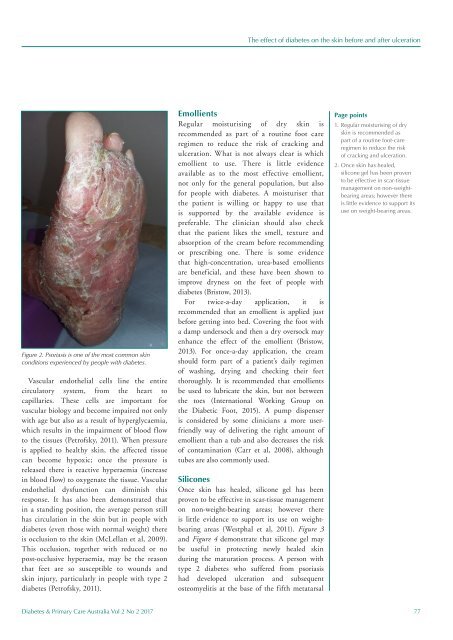DPCA2-2_issue_v3
You also want an ePaper? Increase the reach of your titles
YUMPU automatically turns print PDFs into web optimized ePapers that Google loves.
The effect of diabetes on the skin before and after ulceration<br />
Figure 2. Psoriasis is one of the most common skin<br />
conditions experienced by people with diabetes.<br />
Vascular endothelial cells line the entire<br />
circulatory system, from the heart to<br />
capillaries. These cells are important for<br />
vascular biology and become impaired not only<br />
with age but also as a result of hyperglycaemia,<br />
which results in the impairment of blood flow<br />
to the t<strong>issue</strong>s (Petrofsky, 2011). When pressure<br />
is applied to healthy skin, the affected t<strong>issue</strong><br />
can become hypoxic; once the pressure is<br />
released there is reactive hyperaemia (increase<br />
in blood flow) to oxygenate the t<strong>issue</strong>. Vascular<br />
endothelial dysfunction can diminish this<br />
response. It has also been demonstrated that<br />
in a standing position, the average person still<br />
has circulation in the skin but in people with<br />
diabetes (even those with normal weight) there<br />
is occlusion to the skin (McLellan et al, 2009).<br />
This occlusion, together with reduced or no<br />
post-occlusive hyperaemia, may be the reason<br />
that feet are so susceptible to wounds and<br />
skin injury, particularly in people with type 2<br />
diabetes (Petrofsky, 2011).<br />
Emollients<br />
Regular moisturising of dry skin is<br />
recommended as part of a routine foot care<br />
regimen to reduce the risk of cracking and<br />
ulceration. What is not always clear is which<br />
emollient to use. There is little evidence<br />
available as to the most effective emollient,<br />
not only for the general population, but also<br />
for people with diabetes. A moisturiser that<br />
the patient is willing or happy to use that<br />
is supported by the available evidence is<br />
preferable. The clinician should also check<br />
that the patient likes the smell, texture and<br />
absorption of the cream before recommending<br />
or prescribing one. There is some evidence<br />
that high-concentration, urea-based emollients<br />
are beneficial, and these have been shown to<br />
improve dryness on the feet of people with<br />
diabetes (Bristow, 2013).<br />
For twice-a-day application, it is<br />
recommended that an emollient is applied just<br />
before getting into bed. Covering the foot with<br />
a damp undersock and then a dry oversock may<br />
enhance the effect of the emollient (Bristow,<br />
2013). For once-a-day application, the cream<br />
should form part of a patient’s daily regimen<br />
of washing, drying and checking their feet<br />
thoroughly. It is recommended that emollients<br />
be used to lubricate the skin, but not between<br />
the toes (International Working Group on<br />
the Diabetic Foot, 2015). A pump dispenser<br />
is considered by some clinicians a more userfriendly<br />
way of delivering the right amount of<br />
emollient than a tub and also decreases the risk<br />
of contamination (Carr et al, 2008), although<br />
tubes are also commonly used.<br />
Silicones<br />
Once skin has healed, silicone gel has been<br />
proven to be effective in scar-t<strong>issue</strong> management<br />
on non-weight-bearing areas; however there<br />
is little evidence to support its use on weightbearing<br />
areas (Westphal et al, 2011). Figure 3<br />
and Figure 4 demonstrate that silicone gel may<br />
be useful in protecting newly healed skin<br />
during the maturation process. A person with<br />
type 2 diabetes who suffered from psoriasis<br />
had developed ulceration and subsequent<br />
osteomyelitis at the base of the fifth metatarsal<br />
Page points<br />
1. Regular moisturising of dry<br />
skin is recommended as<br />
part of a routine foot-care<br />
regimen to reduce the risk<br />
of cracking and ulceration.<br />
2. Once skin has healed,<br />
silicone gel has been proven<br />
to be effective in scar-t<strong>issue</strong><br />
management on non-weightbearing<br />
areas; however there<br />
is little evidence to support its<br />
use on weight-bearing areas.<br />
Diabetes & Primary Care Australia Vol 2 No 2 2017 77
















